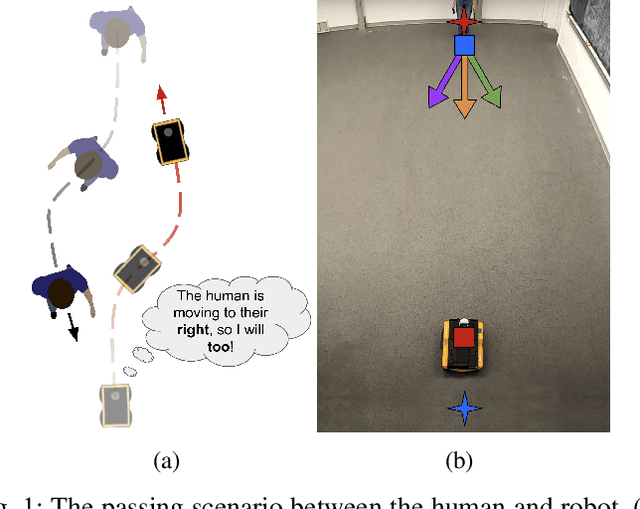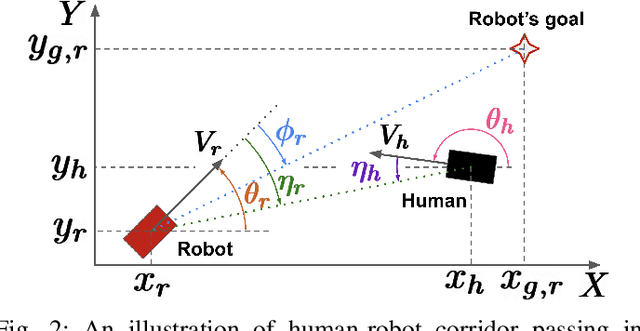Shinkyu Park
Cooperative Grasping for Collective Object Transport in Constrained Environments
Sep 03, 2025Abstract:We propose a novel framework for decision-making in cooperative grasping for two-robot object transport in constrained environments. The core of the framework is a Conditional Embedding (CE) model consisting of two neural networks that map grasp configuration information into an embedding space. The resulting embedding vectors are then used to identify feasible grasp configurations that allow two robots to collaboratively transport an object. To ensure generalizability across diverse environments and object geometries, the neural networks are trained on a dataset comprising a range of environment maps and object shapes. We employ a supervised learning approach with negative sampling to ensure that the learned embeddings effectively distinguish between feasible and infeasible grasp configurations. Evaluation results across a wide range of environments and objects in simulations demonstrate the model's ability to reliably identify feasible grasp configurations. We further validate the framework through experiments on a physical robotic platform, confirming its practical applicability.
Opinion-Driven Decision-Making for Multi-Robot Navigation through Narrow Corridors
Apr 29, 2025Abstract:We propose an opinion-driven navigation framework for multi-robot traversal through a narrow corridor. Our approach leverages a multi-agent decision-making model known as the Nonlinear Opinion Dynamics (NOD) to address the narrow corridor passage problem, formulated as a multi-robot navigation game. By integrating the NOD model with a multi-robot path planning algorithm, we demonstrate that the framework effectively reduces the likelihood of deadlocks during corridor traversal. To ensure scalability with an increasing number of robots, we introduce a game reduction technique that enables efficient coordination in larger groups. Extensive simulation studies are conducted to validate the effectiveness of the proposed approach.
Learning Policies for Dynamic Coalition Formation in Multi-Robot Task Allocation
Dec 29, 2024Abstract:We propose a decentralized, learning-based framework for dynamic coalition formation in Multi-Robot Task Allocation (MRTA). Our approach extends Multi-Agent Proximal Policy Optimization (MAPPO) by incorporating spatial action maps, robot motion control, task allocation revision, and intention sharing to enable effective coalition formation. Extensive simulations demonstrate that our model significantly outperforms existing methods, including a market-based baseline. Furthermore, we assess the scalability and generalizability of the proposed framework, highlighting its ability to handle large robot populations and adapt to diverse task allocation environments.
TAB-Fields: A Maximum Entropy Framework for Mission-Aware Adversarial Planning
Dec 03, 2024Abstract:Autonomous agents operating in adversarial scenarios face a fundamental challenge: while they may know their adversaries' high-level objectives, such as reaching specific destinations within time constraints, the exact policies these adversaries will employ remain unknown. Traditional approaches address this challenge by treating the adversary's state as a partially observable element, leading to a formulation as a Partially Observable Markov Decision Process (POMDP). However, the induced belief-space dynamics in a POMDP require knowledge of the system's transition dynamics, which, in this case, depend on the adversary's unknown policy. Our key observation is that while an adversary's exact policy is unknown, their behavior is necessarily constrained by their mission objectives and the physical environment, allowing us to characterize the space of possible behaviors without assuming specific policies. In this paper, we develop Task-Aware Behavior Fields (TAB-Fields), a representation that captures adversary state distributions over time by computing the most unbiased probability distribution consistent with known constraints. We construct TAB-Fields by solving a constrained optimization problem that minimizes additional assumptions about adversary behavior beyond mission and environmental requirements. We integrate TAB-Fields with standard planning algorithms by introducing TAB-conditioned POMCP, an adaptation of Partially Observable Monte Carlo Planning. Through experiments in simulation with underwater robots and hardware implementations with ground robots, we demonstrate that our approach achieves superior performance compared to baselines that either assume specific adversary policies or neglect mission constraints altogether. Evaluation videos and code are available at https://tab-fields.github.io.
Integrating Disambiguation and User Preferences into Large Language Models for Robot Motion Planning
Apr 22, 2024Abstract:This paper presents a framework that can interpret humans' navigation commands containing temporal elements and directly translate their natural language instructions into robot motion planning. Central to our framework is utilizing Large Language Models (LLMs). To enhance the reliability of LLMs in the framework and improve user experience, we propose methods to resolve the ambiguity in natural language instructions and capture user preferences. The process begins with an ambiguity classifier, identifying potential uncertainties in the instructions. Ambiguous statements trigger a GPT-4-based mechanism that generates clarifying questions, incorporating user responses for disambiguation. Also, the framework assesses and records user preferences for non-ambiguous instructions, enhancing future interactions. The last part of this process is the translation of disambiguated instructions into a robot motion plan using Linear Temporal Logic. This paper details the development of this framework and the evaluation of its performance in various test scenarios.
Threshold Decision-Making Dynamics Adaptive to Physical Constraints and Changing Environment
Dec 11, 2023Abstract:We propose a threshold decision-making framework for controlling the physical dynamics of an agent switching between two spatial tasks. Our framework couples a nonlinear opinion dynamics model that represents the evolution of an agent's preference for a particular task with the physical dynamics of the agent. We prove the bifurcation that governs the behavior of the coupled dynamics. We show by means of the bifurcation behavior how the coupled dynamics are adaptive to the physical constraints of the agent. We also show how the bifurcation can be modulated to allow the agent to switch tasks based on thresholds adaptive to environmental conditions. We illustrate the benefits of the approach through a decentralized multi-robot task allocation application for trash collection.
Distributed Multi-Robot Multi-Target Tracking Using Heterogeneous Limited-Range Sensors
Nov 03, 2023



Abstract:This paper presents a cooperative multi-robot multi-target tracking framework aimed at enhancing the efficiency of the heterogeneous sensor network and, consequently, improving overall target tracking accuracy. The concept of normalized unused sensing capacity is introduced to quantify the information a sensor is currently gathering relative to its theoretical maximum. This measurement can be computed using entirely local information and is applicable to various sensor models, distinguishing it from previous literature on the subject. It is then utilized to develop a distributed coverage control strategy for a heterogeneous sensor network, adaptively balancing the workload based on each sensor's current unused capacity. The algorithm is validated through a series of ROS and MATLAB simulations, demonstrating superior results compared to standard approaches that do not account for heterogeneity or current usage rates.
Opinion-Driven Robot Navigation: Human-Robot Corridor Passing
Oct 04, 2022



Abstract:We propose, analyze, and experimentally verify a new approach for robot social navigation in human-robot corridor passing that is driven by nonlinear opinion dynamics. The robot forms an opinion over time in response to its observations, and its opinion drives its motion control. The algorithm inherits a key feature of the opinion dynamics: deadlock, also known as the "freezing robot" problem, is guaranteed to be broken even if the robot has no bias or evidence for whether it is better off passing on the right or the left. The robot can also overcome a bias that is in conflict with the passage choice the human makes. The approach enables rapid and reliable opinion formation, which makes for rapid and reliable navigation. We verify our analytical results on deadlock breaking and rapid and reliable passage with human-robot experiments. We further verify through experiments that a single design parameter can tune the trade-off between efficiency and reliability in human-robot corridor passing. The new approach has the additional advantage that it does not rely on a predictive model of human behavior.
 Add to Chrome
Add to Chrome Add to Firefox
Add to Firefox Add to Edge
Add to Edge